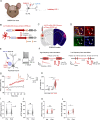Cholecystokinin-expressing GABA neurons elicit long-term potentiation in the cortical inhibitory synapses and attenuate sound-shock associative memory
- PMID: 40854983
- PMCID: PMC12379247
- DOI: 10.1038/s41598-025-17065-3
Cholecystokinin-expressing GABA neurons elicit long-term potentiation in the cortical inhibitory synapses and attenuate sound-shock associative memory
Abstract
Neuronal interactions between inhibitory and excitatory neurons play a pivotal role in regulating the balance of excitation and inhibition in the central nervous system (CNS). Consequently, the efficacy of inhibitory/excitatory synapses profoundly affects neural network processing and overall neuronal functions. Here, we describe a novel form of long-term potentiation (LTP) induced at cortical inhibitory synapses and its behavioral consequences. We show that high-frequency laser stimulation (HFLS) of GABAergic neurons elicit inhibitory LTP (i-LTP) in pyramidal neurons of the auditory cortex (AC). The selective activation of cholecystokinin-expressing GABA (GABACCK) neurons is essential for the formation of HFLS-induced i-LTP, rather than the classical parvalbumin (PV) neurons and somatostatin (SST) neurons. Intriguingly, i-LTP can be evoked in the AC by adding the exogenous neuropeptide CCK when PV neurons and SST neurons are selectively activated in PV-Cre and SST-Cre mice, respectively. Additionally, we discovered that low-frequency laser stimulation (LFLS) of PV neurons paired with HFLS of GABACCK neurons potentiates the inhibitory effect of PV interneurons on pyramidal neurons, thereby generating heterosynaptic i-LTP in the AC. Notably, light activation of GABACCK neurons in CCK-Cre mice significantly attenuates sound- shock associative memory, while stimulation of PV neurons does not affect this memory in PV-Cre mice. In conclusion, these results demonstrate a critical mechanism regulating the excitation-inhibition balance and modulating learning and memory in cortical circuits. This mechanism might serve as a potential target for the treatment of neurological disorders, including epilepsy and Alzheimer's disease.
Keywords: Auditory cortex; Cholecystokinin; Interneuron; Long-term potentiation; Neurological disorders.
© 2025. The Author(s).
Conflict of interest statement
Declarations. Competing interests: The authors declare no competing interests.
Figures






Similar articles
-
Peripuberty Is a Sensitive Period for Prefrontal Parvalbumin Interneuron Activity to Impact Adult Cognitive Flexibility.Dev Neurosci. 2025;47(2):127-138. doi: 10.1159/000539584. Epub 2024 Jun 3. Dev Neurosci. 2025. PMID: 38830346 Free PMC article.
-
Syngap1 regulates the synaptic drive and membrane excitability of Parvalbumin-positive interneurons in mouse auditory cortex.Elife. 2025 Aug 14;13:RP97100. doi: 10.7554/eLife.97100. Elife. 2025. PMID: 40810392 Free PMC article.
-
A Novel CCK Receptor GPR173 Mediates Potentiation of GABAergic Inhibition.J Neurosci. 2023 Mar 29;43(13):2305-2325. doi: 10.1523/JNEUROSCI.2035-22.2023. Epub 2023 Feb 22. J Neurosci. 2023. PMID: 36813575 Free PMC article.
-
The role of neuroinflammation in PV interneuron impairments in brain networks; implications for cognitive disorders.Rev Neurosci. 2025 Jan 24;36(5):497-517. doi: 10.1515/revneuro-2024-0153. Print 2025 Jul 28. Rev Neurosci. 2025. PMID: 39842401 Review.
-
Neural ensembles: role of intrinsic excitability and its plasticity.Front Cell Neurosci. 2024 Jul 31;18:1440588. doi: 10.3389/fncel.2024.1440588. eCollection 2024. Front Cell Neurosci. 2024. PMID: 39144154 Free PMC article. Review.
References
-
- Caya-Bissonnette, L. & Béïque, J. C. Half a century legacy of long-term potentiation. Curr. Biol.34(13), R640–R662. 10.1016/j.cub.2024.05.008 (2024). - PubMed
-
- Bliss, T. V. P. & Collingridge, G. L. A synaptic model of memory: Long-term potentiation in the hippocampus. Nature361(6407), 31–39. 10.1038/361031a0 (1993). - PubMed
MeSH terms
Substances
Grants and funding
LinkOut - more resources
Full Text Sources
Medical

